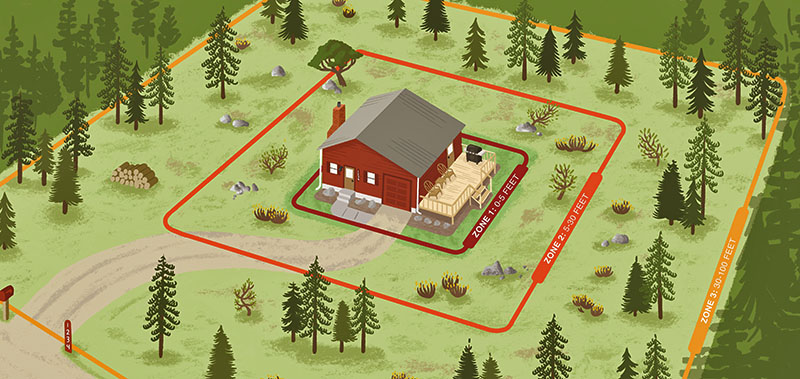Home Ignition Zone Checklists
Follow These Checklists to Prepare Your Home for Wildfire
Take these practical steps to increase the likelihood your home survives a wildfire by addressing the home ignition zone, which is the home itself and the area around it. This will minimize the ability of your home to ignite during a wildfire, in part by reducing or eliminating nearby fuels.
The home ignition zone requires regular, ongoing maintenance to be effective. Trees, grasses and shrubs continue to grow, die and drop leaves each season, and there are ongoing maintenance needs for any structures on your property. Follow these steps to maintain the home ignition zone.
Top Priorities for Structural Ignitability
- Ensure the roof has a Class A fire rating
- Remove all leaves, needles and other debris from all decks, roofs and gutters
- Screen attic, roof, eaves and foundation vents with 1/8-inch metal mesh
- Screen or wall-in stilt foundations and decks with 1/8-inch metal mesh
- Use tempered glass for windows; two or more panes are recommended
- Create 6 inches of vertical clearance between the ground and home siding
- Replace combustible fencing or gates, at least within 5 feet of the home
Top Priorities for Defensible Space
- Mow grass and weeds to a height of 4 inches or less.*
- Rake and remove all pine needles and other flammable debris from a 5-foot radius around the foundation of your home and deck.*
- Treat or mow shrubs that re-sprout aggressively (such as Gambel oak) every 3-5 years or more depending on growth rates.
- Remove branches that hang over the roof and chimney.
- Dispose of slash from thinning trees and shrubs by chipping, hauling to a disposal site or piling in open areas for burning later. Any accumulation of slash that’s chipped or otherwise should be isolated 30 feet or more from the home.*
- Avoid creating continuous areas of wood chips on the ground when chipping logs and/or slash. Break up the layer of wood chips by adding nonflammable material, or allow for wide gaps of at least 3 feet between chip accumulations.
*Address as needed, more than once a year.
Firewood
- Keep firewood stacked uphill from (or at the same elevation as) any structures, and keep the woodpile at least 30 feet away from the home.
- Do not stack firewood between remaining trees, underneath the deck, or on the deck.
- Remove flammable vegetation within 10 feet of woodpiles.
Propane Tanks
- Keep aboveground tanks at least 30 feet from the home, preferably on the same elevation as the house.
- Remove flammable vegetation within 10 feet of all propane tanks and gas meters.
Driveways
- Maintain at least 10 feet between tree crowns and keep trees a minimum of 30 feet back from each side of the driveway along the entire distance from the house to the main access road.
- Remove any remaining ladder fuels beneath trees after thinning.
- Remove any shrubs that are within 10 feet of the outer edge of tree crowns.
- Space shrubs apart at least two-and-a-half times their mature height, as measured from the edge of the shrubs.
- Post signs at the end of the driveway with your house number that are noncombustible, reflective and easily visible to emergency responders.
Solutions for Managing Slash
Properly thin and prune trees and shrubs as you address the home ignition zone. The sticks and other debris left from cutting trees and shrubs is called slash. Slash is a fuel for wildfire, so ensure this debris is properly managed on your property. It is critical that any slash is located as far from your house as possible:
- Spread slash and wood chips over a large area of ground to avoid heavy accumulations and large piles. Being close to the ground will help speed decomposition.
- Burn slash piles, but before doing so, always contact your county sheriff’s office or local fire department for current information or possible restrictions.
- Lop and scatter slash by cutting it into small pieces (generally less than 24 inches long) and distributing it over a wide patch of ground, to a depth not exceeding 18 inches. Material over 4 inches in diameter should not be scattered.
Additional Resources
For further guidance on how to prepare your home for wildfire:
- Home Ignition Zone Guide (2.7 MB PDF)
- La Zona De Ignición Del Hogar (1.1 MB PDF) – Spanish version of Home Ignition Zone Guide
- Protect Your Home and Property from Wildfire


